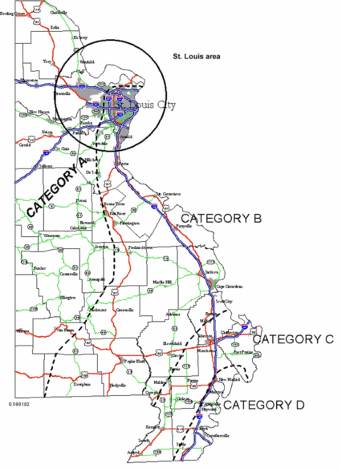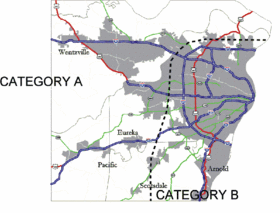Difference between revisions of "Category:756 Seismic Design"
(updated files and links for LFD and LRFD Seismic Flowcharts) |
|||
| (22 intermediate revisions by 4 users not shown) | |||
| Line 1: | Line 1: | ||
| − | {| | + | {| style="margin: 1em auto 1em auto" align="right" |
|- | |- | ||
| − | | | + | |[[Image:756 Figure Seismic Performance Categories.gif|340px|center|thumb|<center>'''LFD Seismic Performance Categories'''<br/>The entire state of Missouri outside of<br/>Categories B, C and D is Category A.</center>]]||[[Image:756 Figure St. Louis Area.gif|280px|center|thumb|<center>'''LFD Seismic Performance Categories for St. Louis Area'''</center>]] |
|} | |} | ||
| − | |||
| − | + | ==LFD== | |
| − | [[ | + | All new bridges on the state system shall include some level of seismic design and/or detailing to resist earthquakes per the [[media:756 LFD Bridge Seismic Design Flowchart 13 021 11092018 R1.pdf|LFD Bridge Seismic Design Process Flowchart]] and an expected seismic event for a given return period. For example, for a multi span bridge in Seismic Performance Categories B, C or D, both design and detailing work is needed or detailing work only needed shall be determined as per “LFD Bridge Seismic Design Process Flowchart”. |
| + | {|style="padding: 0.3em; margin-right:15px; border:2px solid #a9a9a9; text-align:center; font-size: 95%; background:#f5f5f5" width="160px" align="left" | ||
| + | |- | ||
| + | |[[media:756 LFD Bridge Seismic Design Flowchart 13 021 11092018 R1.pdf|LFD Bridge Seismic Design Process Flowchart]] | ||
| + | |} | ||
| + | |||
| + | When existing bridges are identified as needing repairs or maintenance, a decision on whether to include seismic retrofitting in the scope of the project shall be determined per the “LFD Bridge Seismic Design Process Flowchart”, the extent of the rehabilitation work and the expected life of the bridge after the work. For example, if the bridge needs painting or deck patching, no retrofitting is recommended. However, redecking or widening the bridge indicates that MoDOT is planning to keep the bridge in the state system with an expected life of at least 30 more years. In these instances, the project core team should consider cost effective methods of retrofitting the existing bridge. | ||
| + | |||
| + | ==LRFD== | ||
| + | {|style="padding: 0.3em; margin-right:15px; border:2px solid #a9a9a9; text-align:center; font-size: 95%; background:#f5f5f5" width="160px" align="left" | ||
| + | |- | ||
| + | |[[media:756_LRFD_Bridge_Seismic_Design_Flowchart_13_021_11092018_R1.pdf|LRFD Bridge Seismic Design Process Flowchart]] | ||
| + | |} | ||
| + | |||
| + | All new bridges on the state system shall include some level of seismic design and/or detailing to resist earthquakes per the [[media:756_LRFD_Bridge_Seismic_Design_Flowchart_13_021_11092018_R1.pdf|LRFD Seismic Bridge Design Process Flowchart]] and an expected seismic event for a given return period. For example, for a bridge in Seismic Design Categories A, B, C or D, seismic analysis or seismic detailing shall be determined as per “LRFD Seismic Bridge Design Process Flowchart”. | ||
Revision as of 16:00, 29 December 2022
LFD
All new bridges on the state system shall include some level of seismic design and/or detailing to resist earthquakes per the LFD Bridge Seismic Design Process Flowchart and an expected seismic event for a given return period. For example, for a multi span bridge in Seismic Performance Categories B, C or D, both design and detailing work is needed or detailing work only needed shall be determined as per “LFD Bridge Seismic Design Process Flowchart”.
| LFD Bridge Seismic Design Process Flowchart |
When existing bridges are identified as needing repairs or maintenance, a decision on whether to include seismic retrofitting in the scope of the project shall be determined per the “LFD Bridge Seismic Design Process Flowchart”, the extent of the rehabilitation work and the expected life of the bridge after the work. For example, if the bridge needs painting or deck patching, no retrofitting is recommended. However, redecking or widening the bridge indicates that MoDOT is planning to keep the bridge in the state system with an expected life of at least 30 more years. In these instances, the project core team should consider cost effective methods of retrofitting the existing bridge.
LRFD
| LRFD Bridge Seismic Design Process Flowchart |
All new bridges on the state system shall include some level of seismic design and/or detailing to resist earthquakes per the LRFD Seismic Bridge Design Process Flowchart and an expected seismic event for a given return period. For example, for a bridge in Seismic Design Categories A, B, C or D, seismic analysis or seismic detailing shall be determined as per “LRFD Seismic Bridge Design Process Flowchart”.

